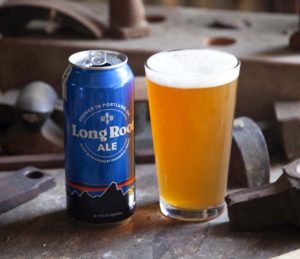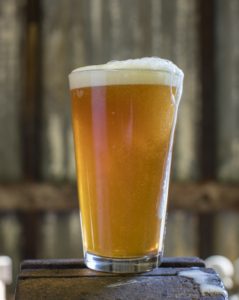Beer and coffee make nice bookends. One before the other can put you in the right frame of mind – I usually like coffee before beer, but whichever comes first all depends on what frame you want to be in.
The top climate change headlines out this week hold good news for beer lovers and bad news for coffee drinkers. So, for those of us who are both, I guess it’s a wash.
First the beer news.
Clothing maker Ventura, Calif.-based Patagonia Inc. has launched a new crafty type beer under its Patagonia Provisions company.
Long Root Ale is reportedly the first beer to be made with Kernza, which the company calls “a perennial grain grown using regenerative agriculture practices.”
Business Insider was one of the first news sites to report on the ambrosial offering, writing that the Land Institute began breeding Kernza from a species of wheat grass in 2003:

Photo by Amy Kumler
“Farmers are still experimenting with it, but have thus far found that Kernza crops require only half as much water as wheat due to their long roots. The plant also thrives without tilling, which helps prevent soil erosion (the wearing away of topsoil by wind and water after farming). And since Kernza crops don’t die after harvest, they can grow — and capture carbon — year-round, eliminating the need to start over every season.”
Like any good beer maker, Patagonia Provisions describes the pale ale using pleasingly nectarous language – “Beyond the crafted grapefruit hop flavor, beyond the balanced maltiness lies a story as refreshing as its dry, crisp finish” – and states that it’s brewed by Portland, Ore.-based Urban Brewery with organic two-row barley, organic yeast and a blend of organic Northwest hops.
The result, the maker says, is a brew “with resinous, grapefruit hop aromas and flavor and a balanced maltiness,” while the Kernza adds a “slight spiciness to the dry, crisp finish.”
Despite the catchy headline that may have brought readers of a like-mind here, you actually cannot buy stock in Patagonia, which remains a private entity.
But if reading this makes you thirsty, the beer is available in 16-ounce cans in most Whole Foods markets on the West Coast.
Public Privates
A new report out from CDP, a global disclosure system for companies, cities, states and regions to manage their environmental impacts, analyzes data from 533 cities that shows an “emerging case for collaborative climate action between cities, regions, businesses and investors.”
The majority of these cities identified more than 1,000 economic opportunities linked to climate change, including 299 cities that are looking to develop new business industries, such as clean technology, the report states.
Many cities are already actively looking to partner with the private sector on climate change. Cities highlighted 720 climate change-related projects worth a combined $26 billion that they want to work with businesses on, the report states.
The total cost of climate change-related projects being sought in North America is $8 billion, and the report shows that the top three project areas include: energy efficiency/retrofit; renewable energy; and transport.
The report also shows more cities are eyeing emissions reductions. One-in-10 cities reported undertaking a city-wide emissions inventory in 2011. Now, four-in-10 cities report doing so, the report shows. Additionally, 190 cities have set city-scale emissions reduction targets with more than 3,000 actions to reduce emissions.

Photo by Tim Davis
Hot as Eemian
The Guardian reported this week that the global temperature has risen to a level not seen for 115,000 years.
The article refers to a new paper from a former senior NASA climate scientist and 11 other experts that asserts the temperature average for 2016 is likely to be 2.25F above pre-industrial times, which follows a warming trend in which the world has heated up at a rate of 0.32 degrees F per decade over the past 45 years.
“This rate of warming is bringing Earth in line with temperatures last seen in the Eemian period, an interglacial era ending 115,000 years ago when there was much less ice and the sea level was 6-9 meters (20-30ft) higher than today,” the Guardian article states.
The report states that the warming and rising sea levels will require “daunting technological advances” costing coming generations hundreds of trillions of dollars.
Evidently the Eemian period was the second-to-latest interglacial period of the current Ice Age, before the more recent being the Holocene period. According to Wikipedia, this period is also called Sangamonian, Ipswichian, Mikulin, Kaydaky, Valdivia or Riss-Würm. None of which some of us have ever heard of – including Eemian.
Strain on the Java Chain
Whether you need your daily triple venti, half-sweet, non-fat, caramel macchiato, or a straight black piping hot cup of coffee, a recent report doesn’t bode well for those who count themselves among the ranks of java junkies.
The report follows several reports out over the past year that portend bad times for the world’s coffee supply.
The latest is a report from the Climate Institute, “A Brewing Storm: The climate change risks to coffee,” which was commissioned by Fairtrade Australia & New Zealand.
“Without strong action to reduce emissions, climate change is projected to cut the global area suitable for coffee production by as much as 50 percent by 2050,” the report states. “By 2080, wild coffee, an important genetic resource for farmers, could become extinct.”
The report presents “strong evidence” that rising temperatures and altered rainfall patterns are already impacting coffee yields, quality, pests and diseases.
Arabica coffee, which makes up roughly 70 percent of the global coffee supply, seems to be most at risk, according to the report. The yield and flavor of that particular type of coffee are apparently closely linked to climate and weather, particularly temperature and moisture.
Arabica, the higher quality coffee most of us have become used to quaffing daily – not to be confused with Robusta, earmarked for the instant coffee market and which probably is “your grandfather’s cup of coffee” – performs best at 32 to 70 degrees F. Above 73 degrees, the plant grows too fast and fruits too early, damaging bean quality, according to the report.
“Even half a degree (Celsius) at the wrong time can make a big difference in coffee yield, flavour, and aroma,” the report states. “Around the Bean Belt, rising minimum growing temperatures, changes in rainfall patterns, and rising pest and disease incidence, are already making life harder for coffee farmers.”
Ethiopia’s average annual temperature has risen by 2.34 degrees F between 1960 and 2006, while in Mexico, Guatemala, and Honduras, mean temperatures have risen by as much a 1.8 degrees and the average rainfall has dropped off by up to 15 percent since the 1980s, according to the report.
Tanzania, where the livelihoods of 2.4 million people rely on coffee, has reportedly seen yield fall off over the last half-century by roughly 302 pounds per nearly 2.5 acres for every 1.8-degree F rise in Arabica’s minimum temperature, or around 50 percent since the 1960s.
So, why all the recent buzz about the global warming threat to the coffee chain?
It’s an important topic for the drinkers of the roughly 2.25 billion cups of coffee that are estimated to be consumed each day around the world. And I’m only on No. 2 so far.
Past columns:
Was this article valuable?
Here are more articles you may enjoy.



 Vintage Ferrari Owners’ Favorite Mechanic Charged With Theft, Fraud
Vintage Ferrari Owners’ Favorite Mechanic Charged With Theft, Fraud  Harvard Study Again Stirs the Pot on Demotech Ratings of Florida Carriers
Harvard Study Again Stirs the Pot on Demotech Ratings of Florida Carriers  USAA to Lay Off 220 Employees
USAA to Lay Off 220 Employees  Wildfires Are Upending Some of the Safest Bets on Wall Street
Wildfires Are Upending Some of the Safest Bets on Wall Street 

